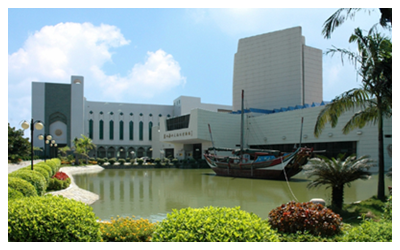Skype: neodalle-travel
Tel: +86 135 7447 2266
E-mail: sales@visitaroundchina.com
 Quanzhou Maritime Museum, was created in 1959, original location was at the Kaiyuan Temple. Quanzhou Maritime Museum is a museum dedicated to China's maritime transportation, the maritime silk road, and the incurring economic and cultural exchange. Through a comprehensive and valuable collection of historical relics, the museum reflects the development history of "Zayton" (another name for the city of Quanzhou), the biggest oriental port during the Middle Ages. It also showcases the important role that Quanzhou played in economic and cultural exchanges with foreign countries.
Quanzhou Maritime Museum, was created in 1959, original location was at the Kaiyuan Temple. Quanzhou Maritime Museum is a museum dedicated to China's maritime transportation, the maritime silk road, and the incurring economic and cultural exchange. Through a comprehensive and valuable collection of historical relics, the museum reflects the development history of "Zayton" (another name for the city of Quanzhou), the biggest oriental port during the Middle Ages. It also showcases the important role that Quanzhou played in economic and cultural exchanges with foreign countries.
In 1991, Quanzhou Maritime Museum was moved to the east of the picturesque East Lake Park in Quanzhou City. Displays are housed in a structure shaped like a brig (a ship equipped with two full masts), and cover an area of 7,000 sq kilometers . The museum has four exhibition halls: Quanzhou Overseas Communications, Quanzhou Religious Sculpture, Ancient Chinese Sailboats Models, and Quanzhou Customs and Culture. At present, the first three are open to the public.
The Overseas Communications History Exhibition Center showcases a large number of cultural relics and models. The relics well illustrate the vicissitude of the ancient seaport of this city. The exhibits are divided into four categories, according to the historical events represented, and are displayed in exhibition areas respectively. The exhibits paint a vivid portrait of Quanzhou's overseas trade throughout the past 2,000 years. Highlights include the portrayal of Zhenghe's successful travels to the Indian Ocean, which reflects the prosperity of China's overseas ventures during the Ming Dynasty (1368-1644).
This city has been a cultural and religious melting pot since ancient times. The Quanzhou Religious Sculpture Exhibition Center testifies to this. The Sculpture Exhibition Center consists of four exhibition areas which display various architectural structures, gravestones and stone tablets related to Islam, Christianity, Hinduism and Manichaeism. Among the artifacts presented, Islamic relics are dominant, ranking first both in terms of quantity and content. These relics indicate that it has long been an open city, showing that the Chinese people have always been inclusive and willing to draw on the strengths of various civilizations.
In the Ancient Chinese Sailboats Models Exhibition Center, you will find shipwrecks and models of many ancient vessels. Among the various exhibits, the shipwreck excavated in 1974 from Quanzhou Bay is of great historical significance. It is an oceangoing wooden vessel, built in the 13th century, measuring of 24.2 meters (79.4 feet) in length and 9.2 meters (30.2 feet) in width. The body of the ship consists of 13 watertight compartments. If renovated to its original state, it is estimated that it would stand 34 meters (112 feet) long, and 11 meters (36 feet) wide, and weigh over 200 tons. The relics unearthed in this wreck include spices, medicinal herbs, copper and iron coins, chinaware and pottery. This and other exhibits demonstrate the superb shipbuilding techniques of the ancient local people, and the prosperity brought by of overseas trade in ancient times.
As the starting point of the Maritime Silk Road, this city was the center of overseas trade and other exchanging activities of China in ancient times. The city's history is an important part of China's overseas communications legacy, and this Museum gives an excellent portrayal of the city's sea-faring vicissitude throughout the ages.
Travel Tips
Add: 425 Donghu Street, Fengze district, Quanzhou, Fujian province
Admission Fee: CNY 0
Opening Hours: 09:00-18:00 (17:30 in winter)
 Ask Questions ?
Ask Questions ?